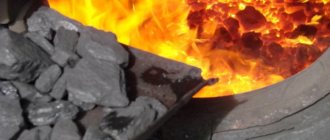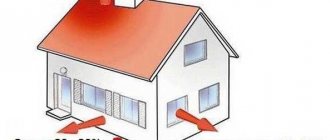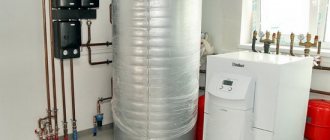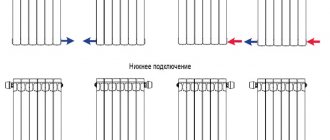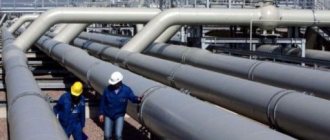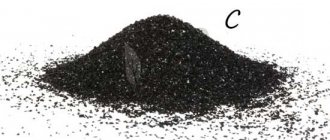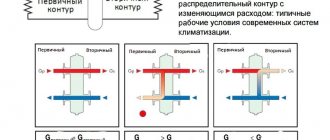Due to the steady increase in the cost of electricity and natural gas tariffs, the use of various types of solid fuel for heating is becoming increasingly important. It is not surprising that owners of private houses strive to find other options for economical heating and install heat generators that run on wood. But before purchasing a solid fuel boiler, every homeowner wants to understand what the daily operation of such a heat source will cost. To do this, first of all, you should determine the consumption of firewood for heating the house, which will be discussed in this article.
Best answers
Zhanna K:
my neighbor’s house is 6*6, that is, 36 square meters, made of timber, with an attic, he took 10 cubic meters last year, that is, Kamaz in bulk, barely enough for the winter, that is, 2 Kamaz trucks will probably be enough for you. The stove is also Butakova, it was always warm in the house.
Mikhalych:
it’s easy to calculate from the daily “norm” 80-120 liters per day passport request x for 30 x 8 months = 19 - 29 m3 WAREHOUSE (!) i.e. folded, not cubed from round timber...)))))
Anaida Zagoskina:
A lot depends on the stoves that heat your home. As a rule, such a room cannot be heated with one stove. If you have a baker and a stove, that is, two ovens, then 10 cubes will be enough. Heat the baker in the morning, and heat the stove or floods closer to lunch. The average temperature in the living space will be maintained constantly. If the bakery has a good chimney, then the additional stove can be heated in the evening.
Nikita:
I live in the north, a house of 90 square meters, 150x150 timber, a brick stove with a homemade water boiler, enough for 10 cubic meters (unsawn) for the whole winter + a bathhouse in winter 2 rubles a week, in summer every day. If you can do better with this crap, feel free to scrap it
Sergey Bogatyrev:
house 40 m 17 cubic meters but this is with a margin
How much wood is required to heat a house?
We always look at the quality of the firewood we buy. Soft wood burns quickly, but does not produce much heat. Preference is given to hard rocks, which, although they burn slowly, provide a lot of heat to the project. Rotten firewood very often comes across on sale. When you prepare firewood yourself, this will never happen. And most often they sell raw wood.
It turns out that for a private house or cottage it is best to find about 10 cubic meters of firewood for the season. In order not to spend money on buying chopped firewood, you can start harvesting it yourself. Moreover, near the summer cottage there will always be a forest where there is a fallen old tree. An excellent option for preparing firewood is to take advantage of the moment when someone is dismantling an old wooden house.
Equipment for preparing firewood for the winter
You cannot prepare a lot of firewood with a hacksaw or an ax. In addition, you need to put in a lot of effort.
In order to carry out preparation work, you need to buy special tools, of which there are not so many.
In order to cut a tree trunk in the forest, you need to choose a good chainsaw. The best option is a device with a power of up to two kilowatts. If the work will be carried out near the house, then there is an option to use an electric saw. There are types of saws on sale that are equipped with batteries. If the work will be carried out very often, it is recommended to buy semi-professional saws. Their power is higher than two kilowatts, and their price is higher.
Then, to chop firewood, you need to buy a high-quality horizontal type wood splitter. For the home, this is the best device that works safely. Working with a wood splitter is simple: you need to turn on the device, which runs on electricity, then put in a log, and then wait for the knife to split it.
There will be trash after the work. And here you will need a shredder that can be used to process the waste. Wood chips, shavings, and leaves can be quickly turned into fertilizer for the garden.
If you want to purchase high-quality equipment, you will have to shell out a lot of money. However, the tools will last a long time. After a while they will fully pay for themselves. For those who think that buying ready-made firewood is cheaper, they are deeply mistaken. For example, what does it cost just to deliver ready-made firewood, and then you also need to store it. Firewood is stored under special sheds or in woodpiles.
Do-it-yourself firewood shed at the dacha, photo
Sheds for storing firewood in winter at the dacha
shed for storing firewood in winter
Experts have proven that self-harvesting wood is much cheaper for the owner, even if he has spent significant amounts of money on purchasing garden equipment.
Basic ways to save heat
Economical heating of a private house with wood has become possible thanks to the use of modern stoves: fireplaces with closed fireboxes have doubled the efficiency, and it reaches 75%, just like good gas stoves. Even if you decide to install a regular Russian stove, its efficiency can also vary significantly.
When heating a house with wood, consumption can be reduced using simple “rustic” methods that have been used for decades. A few basic measures will make it possible to significantly reduce heating costs:
The optimal amount of heat is provided only by dry firewood, the combustion of which produces clear smoke with a pleasant woody smell. When burning wet wood, white steam appears - the evaporation of water leads to wasted heat loss and ineffective combustion of fuel.
It is not difficult to distinguish dry wood: if you hit one log on another, the sound should be clear. It is important to ensure that firewood is stored correctly so that it will always be ready for use.
The efficiency of the stove is significantly reduced if the chimney is clogged with ash and soot. At the same time, traction deteriorates, and due to an insufficient supply of oxygen, the fuel does not burn completely, giving off a minimum of heat.
In addition, toxic carbon monoxide can be released, which can negatively affect human health. Regular cleaning of furnaces can completely solve the problem: removing soot from the walls increases the performance of the entire system.
There is another method, which, according to home owners, makes it possible to reduce fuel consumption by half. It involves taking combustion air not from the room, but from the street: the increased flow of oxygen allows the wood to burn out entirely, while it will not take heat from the house.
Thus, modern gas boilers are initially designed to take air from the street. When modifying the design, the stove can take air from the basement of the house.
The most important condition for saving fuel is proper insulation of the house. It is necessary to insulate not only the walls, but also the floor, foundation, and roof.
Most of the heat simply leaves the house through unsealed cracks in the walls or cold bridges in the under-roof space. For your home, you can use modern insulation in combination with waterproofing and vapor barrier membranes.
An economical wood-burning stove for heating a house involves the use of a water or air circuit for heating. In this case, the heat will be evenly distributed throughout the rooms, and for this it is not necessary to use a large amount of fuel.
Such heating is possible by installing an additional heat exchanger in the furnace structure: the most common solution is the so-called “water jacket”. The water is heated by the combustion of fuel and enters the piping system to the radiators, after which it returns to the furnace.
Fireplaces and fireplace inserts cost savings, highest quality and convenient purchase
Fireplaces and fireplace inserts for heating – features of selection and application:
When choosing a fireplace, you should understand that it is primarily a heating device. That is why its acquisition should be taken with the utmost seriousness.
It is important to consider the technical capabilities, purpose and design features of the models you choose. You also need to remember that fireplace inserts from different manufacturers differ significantly from each other in precisely these indicators
Despite this, externally, fireplace inserts can be very similar.
How to reduce home heating costs?
Fireplace inserts can perform the function of heating equipment: be both the main and auxiliary source of heating in the house. But not every fireplace insert can heat a house. Fireplace inserts can be either for decorative purposes (with intermittent combustion) or with a heating function (continuous combustion).
Two types of functional fireplace inserts will help you save on heating your home:
- – with air heating;
- – with water heating.
To heat a water heating system, you need to buy a fireplace with a water circuit. It will perform the work of a solid fuel boiler and fireplace at the same time. Most often, a water fireplace is used in a system with another heat source, for example, a gas or electric boiler. When the fireplace is operating, the other source is automatically switched off. A fireplace with a water circuit can also independently heat the entire house. This saves money on heating your home.
The efficiency of a fireplace-based air heating system depends on many factors:
If it is not possible to install a traditional wood-burning fireplace, and the dream of home comfort with a fireplace does not leave you, we suggest buying an electric fireplace with a 3D flame effect. For country houses or cold rooms, free-standing fireplaces and stoves that do not need finishing are ideal. We can also offer you stoves for baths and saunas.
To purchase a fireplace and order its installation:
You can send us a house plan by email, or order a visit from our specialist to take measurements on site. We will make you a free commercial offer for a fireplace heating system, which will indicate all the necessary equipment.
A good fireplace can really heat up your home quickly. You won't turn your beautiful living room into a boiler room, since you won't have to add wood to the fireplace every hour. Our fireplace inserts allow one load of wood to burn for a long time, even up to 12 hours.
You can buy fireplaces, fireplace inserts in Ukraine or other products presented by us by ordering them by phone or through an online store. In all cities of Ukraine we deliver by transport service.
Our main advantages:
- – individual approach.
- – only high-quality goods.
- – direct deliveries from the manufacturer.
- – official warranty from the manufacturer for up to 10 years.
- – shortest delivery and installation times.
- – affordable prices for fireplace inserts.
Coal heating equipment
Coal ovens
A conventional stove can only heat one or two rooms, even if you use coal rather than wood to heat the house. True, it can be improved by embedding a heat exchanger for water heating inside the brickwork. The stove is good in its own way, but sometimes it can be dangerous due to the fact that it provokes carbon monoxide poisoning.
Important. The stove chimney valve can be closed only after the coal has completely burned and the flames have disappeared from the firebox. For heating a cottage with coal, a heating unit such as a boiler is much more efficient, reliable and safe.
For heating a cottage with coal, a heating unit such as a boiler is much more efficient, reliable and safe.
Coal solid fuel heating boilers
The diagram shows the design of an improved coal boiler
The design of a coal heating boiler is simple, but very effective. Its cast iron heat exchanger and powerful grate are resistant to burnout and corrosion. Even the simplest of these devices have been regularly heating homes for many decades. But still, old-style boilers are inferior in performance and heat transfer to their current competitors.
The operating principle of a heating boiler looks like this:
- as soon as a fire is lit in the firebox, a draft is created in the chimney and air is drawn into the fuel chamber;
- the coal heats up and partially burns;
- gaseous products of coal combustion are mixed with the secondary air supplied inside and finally burn;
- the resulting gases give up their temperature to the coolant and are then discharged through the chimney.
Modern coal-fired heating boilers consistently heat residential premises and outbuildings. They consume 2 times less fuel compared to outdated models. Advanced technologies have improved not only the design and design of heating units, but also the very principle of fuel combustion. As a result, now the homeowner does not have to load the next portion of coal into the boiler several times a day and remove accumulated slag.
The enlarged combustion chamber is designed for simultaneous loading of a large amount of coal, which gradually burns out over 6–12 hours. Forced air injection promotes the most complete combustion of fuel. Thanks to this, coal consumption for heating the house is significantly reduced.
Especially for automatic models of heating equipment, it is recommended to purchase eco-pea coal, which has optimal dimensions and is free from dust.
The large bunker of the automated heating boiler ensures long burning of coal
Automated fuel supply from the bunker to the boiler “frees the user’s hands.” He becomes free from the obligation to constantly monitor the operating heating device. The capacity of the bunker is enough for non-stop burning of coal for a week.
Reviews of coal heating demonstrate how satisfied users are with the practicality of automated coal boilers. It is very convenient to start the boiler at the beginning of the heating season, and throughout the winter just add coal to the bunker as it is emptied. You also don’t have to remove ash and slag too often, just a couple of times a month.
Lighting coal for heating in a boiler, especially anthracite, can be difficult for an unaccustomed person. First, the boiler is heated with wood or a special mixture, and then fine coal is added little by little. When combustion becomes stable, you can add anthracite in large portions. Exactly how much and how often will depend on the boiler model and will be more accurately determined in the practice of its use.
Do not use gasoline to ignite coal in a heating boiler!
What to do if the electricity in the house goes out? In this case, the automatic supply of coal to the fuel chamber of the boiler will be stopped. At the same time, the circulation pump will stop working, and water will stagnate in the heat exchanger. But the boiler will not boil, because coal combustion will go into low mode. Then, when power is restored, the coal will reignite.
Solid fuel boiler maintenance
Boiler maintenance measures boil down to the need to clean the heat exchanger and smoke exhaust channels. Soot settles on their surfaces, and this phenomenon reduces the efficiency of the heating unit by 15%. The frequency of cleaning a coal heating boiler can vary: old cast iron models have to be cleaned 2-3 times per season, and modern ones once every 2 years.
For unhindered maintenance of the boiler, there must be free access to it in the room where it is installed.
Which firewood is better
The wood that serves as raw material for firewood is far from identical in its properties.
Hard wood species such as birch, oak, hornbeam, beech, and yew burn hotter, have a high fibrous density, and burn more slowly.
Soft varieties have their advantages, for example: aspen produces 25% less heat than birch, but it perfectly maintains heat in a heated stove. Alder still shares a delightful aroma, as do coniferous varieties. Alder and aspen, added to the stove at the end of heating, remove soot and soot deposits in the chimney. But the formation of plaque, which can lead to clogging of the chimney, occurs during the combustion of essential oils and resins of pine, fir, and spruce. Conifers are also inferior in calorific value to birch and oak, but they dry out faster and are more suitable for kindling. Only fir sparks strongly, and larch emits a lot of carbon monoxide at the end of combustion and you need to be more careful with the damper.
Some types of fruit trees are classified as medium-hard wood and their calorific value is average. They burn, emitting an aroma, and are easy to prepare, since the wood can be split without much effort.
Based on the above, it is difficult to recommend any one type of wood for stove or fireplace firewood. As fuel, hard deciduous tree varieties are the most efficient. Even flame, high heat output, less soot and ash. But the aroma of coniferous trees has a therapeutic effect, and is well suited for lighting. By combining several varieties, it is possible to maintain both the working condition of the chimney, stove, and a comfortable microclimate throughout the cold period, subject to the initial investment in a good one. Otherwise, any heat, along with your funds, will fly into the pipe and evaporate through the cracks.
Long burning boilers.
The last group of boilers that can use solid fuel heating are long-burning boilers. There are several special systems that ensure long-term combustion of fuel. The first is the Canadian Buleryan boiler system. The principle of its operation is based on the presence of a two-chamber wood burning stove, divided horizontally. In the lower chamber, gases are released as a result of smoldering fuel. Entering the upper chamber, they are mixed with secondary air through a jet, which leads to afterburning of the fuel. The second system is Stropuva. It is a tall barrel, the height of which can reach 3 m. The container is filled with fuel and covered with a movable lid, to which a chimney is connected. After igniting the firewood, it begins to burn economically and heat the heat carrier along the jacket of the barrel. Solid fuel heating operating using such a system automatically regulates the air supply.
Amount of firewood for winter
One of the paradoxes of the universe: the more ordinary and familiar an object of natural origin, the more complex its mathematical description. In order to calculate the volume of a Galaxy or star, it is enough to remember a school geometry course. If someone really needs to know the exact volume of a log, it is impossible to do without differential calculus methods. Because of an astronomer's mistake, the average person is neither hot nor cold; But if the fuel reserves for the winter are incorrectly calculated, the cold in the house is ensured.
Everything seems simple: we multiply the duration of the heating season in days by the area of the house and the average daily consumption of firewood. Do not believe this simplicity, it is deceptive and requires many clarifications. In fact, it is also necessary to take into account the height of the ceiling, i.e. not area, but volume. The most interesting thing begins when it comes to the average daily consumption of firewood. This value depends on the calorie content of the fuel, the efficiency of the furnace, climatic conditions, heat loss and many other factors, including the radius of curvature of the master’s hands. The last parameter is an irrational value that can reduce heating efficiency to zero. If you set out to derive a universal formula for accurate calculations, there will be enough material for more than a dozen dissertations. It is much faster to make inquiries from neighbors or former owners of the house.
If you are planning to install a solid fuel boiler, it is easier to calculate its “appetite” - the main technical characteristics are known. The easiest way to get an approximate figure is to use formulas or online calculators posted on specialized websites.
Let's try to calculate.
As a standard, let's take a house with a total area of 150 square meters. m and insulated according to SNiP. In the coldest time, about 100 W/m² will be needed to heat the room. Let's take the average energy consumption as 50 W/m². The heating season lasts 7 months (214 days). With continuous heating we get:
150 m²•50 W/m²•24 h•214 days = 38.52 MWh, which approximately corresponds to 33 Gcal.
The specific lower heat of combustion of absolutely dry firewood is 4440 kcal/kg. During natural drying for about two years, the residual moisture content of the wood is 20%, the specific heat of combustion is 3400 kcal/kg. Let us take the efficiency of a solid fuel boiler to be 70%.
We calculate the required amount of firewood: 33000kcal•1000/3400kcal/kg/ 0.7/0.730 kg/m³≈19 m³, where 0.730 kg/m³ is the density of oak wood. In terms of maple or birch, the required value is 21.3 m³, and for pine – 26.4 m³. In practice, you may need less or more firewood, depending on the state of the house’s thermal insulation and weather conditions.
All-knowing statistics claim that to heat a small insulated log house in central Russia, 4-6 cubic meters of firewood per season is sufficient. The most economically justified supply of firewood is for two or three seasons: current + 1-2 next. In this case, you will probably have enough fuel even for the longest cold period. Another argument: firewood, like good alcohol, only gets better over time.
“God have mercy, what kind of firewood? We are civilized people, we have gas!” – this position is fundamentally wrong. Firstly, because we have the good fortune to live in the most amazing country in the world. Here, from time immemorial, two scenarios have been observed: the unlikely and the worst. Secondly, the civilized world is returning to proven and, most importantly, renewable energy sources. Firewood, straw and peat are all the same as hundreds of years ago, adjusted for modern technology.
Having a solid fuel boiler and at least a year’s supply of firewood in a gasified house is not a whim, but a completely reasonable solution. Optimism is good, but optimism backed by strategic reserves is twice as good.
You can also use our online calculator to calculate the amount of chopped wood for heating a country house, cottage or bathhouse.
Initial data for calculation
The calculations themselves, which determine the amount of wood burned in the boiler firebox, are quite simple. The difficulty is to choose the right source data to perform the calculations.
Of course, the easiest way is to use some online calculator that is posted on various Internet resources, and thus find out for yourself the rates of firewood consumption for heating your home. There is only one way to check the correctness of the calculation: do it yourself, manually.
For this reason, we initially suggest going this way, then you will be confident in the result. But you can check its correctness using several online calculators. Below we will present the methodology and at the same time, as an example, we will calculate the consumption of the amount of firewood for heating a house of 100 m2. But first of all, the initial data, here is their list:
- the type of wood that is supposed to be used to heat the premises;
- their degree of humidity;
- Efficiency of a solid fuel stove or boiler;
- thermal power required to heat the building.
Those who have ever used a stove have probably noticed that when burning wood from different trees, different amounts of heat are released. For example, birch logs produce more heat than poplar or pine.
This happens because different tree species have different densities and calorific values. Also, the amount of firewood per 1 kW of thermal energy depends on its humidity.
The higher it is, the more heat is spent on evaporating water from the fuel, and less is left for heating the house. As a result, more wood will be needed to heat the home.
The efficiency of using the energy contained in wood depends on the efficiency of a particular heat source. For example, a fireplace or a conventional stove releases a lot of energy into the atmosphere along with combustion products, respectively, their efficiency does not exceed 60%.
Another thing is a solid fuel or pyrolysis boiler, whose efficiency can reach 80%; these features must be taken into account when calculating the cost of heating a private home.
The table below provides reference data on the calorific value of 1 m3 of certain types of wood at a certain humidity.
The value of the thermal power required to heat a home is best taken according to the calculation made by specialists during the design of the house. But often homeowners do not have such data; in this case, the amount and cost of firewood for heating can be calculated based on the average value of the required power.
It is determined by a well-known method: heating 10 m2 of premises requires 1 kW of heat under the most unfavorable conditions, and on average per season - 0.5 kW. That is, the average standard for a house with an area of 100 m2 will be 5 kW/h.
Answers from experts
New:
1 cart (4 cubes/4t. rubles) economy, 2 from the belly. But this is provided that there are no cracks, the winter frames are perfect, the ceiling is insulated, and the Russian stove is in working order.
Rada Simbireva:
!0 cu. enough meters. This is approximately 4-5 thousand rubles, depending on the area and the presence of forests in the area.
Lyudmila Demina (Malakhova):
Well. and the men went... Buy a car of wood and burn it, and then draw your own conclusions!
INFERNO:
The amount of firewood depends not on the area of the house, but on its volume. with a ceiling height of 2 meters and 2.5 meters, the difference in the volume that needs to be heated is 100 cubic meters, which is decent. In addition, you need to know what material the house is made of, its heat-retaining ability, and the characteristics of the heating device (stove or boiler). The price of wood depends on the type of wood, sawn or chopped. We sell chopped birch from 1200 to 2500 per cubic meter, depending on the distance from the city and the number of wealthy homeowners in the area.
Nadezhda R:
If we assume that 6 m3 can be stored in a car, then for the winter you need 2 cars, i.e. 12 m3. Our car of firewood costs 6 thousand. Yours may be cheaper...
Elena the beautiful:
If with coal, then 3 cubic meters is enough. Machine-5-6 cu. costs 5-6 thousand. Tambov region. It depends on what kind of winter it will be, of course.
ZhenYok:
it depends on what kind of house it is, big or small, warm or cold, and also on the type of wood, pine burns quickly, gives little heat, aspen is the same, the best choice is birch. I have a five-walled house, the house is closer to a warm one, I need about 1 car (about 5 cubic meters) of birch firewood, this is the minimum, pine so at least two cars
irina gurlova:
And where do you live? In winter it’s +5 here, but there are places that are even colder.
Cyber Phantom:
I wonder how to compare the units “cubic meters” and “little by little”? Apparently you need to know the area of the heated room.
Eugenio DJ:
Depends on how big the stove is. 4-5 cubes are enough.
Tiger:
You need six cubes.
wavan:
365 if you throw it up every night
Antonina Smirnova:
This depends on the winter temperature, the heated area, the quality of the firewood and the length of the heating period. I don't know your details. in Siberia, my mother bought 30 cubic meters of birch firewood. in the Far East, where winter is much shorter, we bought 15 cubic meters. - taking into account that we had a farm and had to cook food for the animals.
SpecWood -:
There are many parameters to take into account, here’s a calculator:
What determines the amount of fuel?
Let's take a closer look at the main calculation criteria:
Wood moisture content. Firewood that has been in the woodshed for at least one or two years is considered optimal for burning.
During this time, they have time to dry and acquire a humidity of at least 15-20%. Because of this, it makes sense to purchase fuel for several years at once: over time, the firewood will not only not deteriorate, but will be even better in terms of energy efficiency.
Type of tree. This is also a very important question: hard hardwoods, such as birch, yew or beech, burn the longest and hottest, they give off the maximum heat.
Pine or spruce burn with less heat, but they are more suitable for kindling; moreover, when burning, they emit a pleasant aroma due to essential oils. It is advisable to combine several types of firewood to avoid clogging the chimney with soot and to ensure maximum heat transfer from the wood.
- Room dimensions. In this case, not only the area of the house plays a role, but also its height, so the consumption of firewood for heating a house of 100 m2 can be very different. Usually, when making calculations, the height of the room is taken as 2.8 meters.
- Heating period. In central Russia, heating is required for approximately 7 months, taking into account not too early spring and autumn. It turns out that the stove will have to be heated for 214 days, and the amount of heat is calculated accordingly.
In addition, the efficiency of heating is affected by the efficiency of the furnace, which depends on its size, type, and correctness of the masonry. The technician’s mistakes lead to unnecessary heat loss, resulting in more fuel being wasted and less heat being produced.
If you have not purchased a new house, it makes sense to find out from the previous owners how much fuel was consumed during the heating season. If the building has just been built and you are confident in the correctness of the stove laying, you can use standard forms for an approximate calculation.
Resolution of the Head of the Novopokrovsky rural settlement of the Novopokrovsky district dated 02/04/2009 N 10
Text of the legal act as of August 2012
In accordance with Decree of the Government of the Russian Federation of May 23, 2006 N 306, taking into account the caloric content of fuel, I decide:
1. Approve solid fuel consumption standards per month of the heating period: coal - 8.5 kg/sq.m, firewood - 0.025 cubic meters/sq.m.
2. Entrust control over the implementation of this Resolution to the deputy head of the Novopokrovsky rural settlement for improvement issues N.P. Kovalya.
3. The resolution comes into force on the day of its official publication.
Head of the Novopokrovsky rural settlement M.I. GRECHUSHKIN
Appendix to the Resolution of the head of the Novopokrovsky rural settlement dated February 4, 2009 N 10
SOLID FUEL CONSUMPTION STANDARDS
——+———————-+——————+——————- ¦ N ¦ Indicator ¦ Per month ¦ In heating ¦ ¦ ¦ ¦ heating ¦ period (based on ¦ ¦ ¦ ¦ period ¦ 6 months) ¦ +—-+———————-+——————+——————+ ¦ 1. ¦Coal supply standard ¦ 8.5 kg/sq.m ¦ 51 kg/sq.m ¦ +—-+———————-+——————+——————+ ¦ 2. ¦Firewood supply standard ¦0.025 cubic meters/sq.m ¦ 0.15 cubic meters/sq.m ¦ ——+———————-+——————+——————-
To calculate the standard for thermal energy consumption per 1 square meter of total area, Decree of the Government of the Russian Federation of May 23, 2006 N 306 (formula 2) was used, taking into account the calorific value of the fuel.
Methodological guidelines of the State Unitary Enterprise of the Academy of Public Utilities named after. K.D. Panfilova (2002, edition 4).
Formula for determining the heating standard (formula 2) (coal)
The heating standard (Gcal per 1 sq.m. per month) is determined by the formula:
Qо Qо No = ——- = —— x 2 = 0.0375 Gcal/sq.m (heating period), S x 12 S x 12
Where:
Qо - the total consumption of thermal energy for heating the residential premises of an apartment building or residential building, determined as the sum of the readings of collective metering devices for the heating period (Gcal) (for 12 households it is 91746.6 Gcal);
S - total area of residential premises of an apartment building or premises of a residential building (sq.m) (for 12 households it is 408,282 sq.m).
P = N x S (Gcal/month).
The average caloric equivalent value for converting natural fuel into conventional fuel for coal from the Donetsk basin is 0.94.
P x 213.2 A = ————, kg (per month/sq.m), 0.94
where 213.2 is Donetsk coal (production of 1 Gcal of heat kg of standard fuel);
0.94 is the equivalent of converting natural fuel into conventional fuel and vice versa.
Necessary thermal energy costs for the heating period:
tin — tср Qо = G x ———— x T (Gcal/heating period), tin — tro
where G is the total heat load for heating residential buildings (heating period) (for 12 households it is 54258400);
tin — internal air temperature of heated residential premises (18°C);
tro is the estimated outside air temperature for design purposes (for Novopokrovskaya -22°C);
tsro - average monthly temperature during the heating period (2.57°C);
T - hours during the heating period (4392).
8.5 x 6 = 51 kg/sq.m.
To calculate the rate of firewood consumption for heating residential households, due to the lack of individual standards, fuel consumption rates in kg of equivalent fuel are accepted.
Calculation methods
To maintain a comfortable temperature in residential premises, when installing a heating system yourself, you need to take into account heat loss through the floor, walls, ceiling, door and window structures. There must be a reserve of power in case of severe frosts.
By volume of heated area
Formula for calculating heat:
Q = V × ΔT × K / 850, where
- Q is the amount of thermal energy, kW/h;
- V—room volume, m³;
- ΔT is the temperature difference between the external and internal air environment;
- K is the coefficient of thermal energy loss;
- 850 is a constant number for converting to kWh.
The volume of heat can be calculated based on the volume of the heated area.
Thermal coefficient values for different objects:
- improved building structures (brick walls, thick floors, double-glazed windows in window openings, 2 layers of insulation) - K = 0.6-0.9;
- standard residential buildings - K = 1-1.9;
- simplified house designs with one layer of thermal insulation and standard windows - K = 2-2.9;
- wooden buildings - K = 3-4.
By room area
When calculating the amount of heat required for a room, many nuances are taken into account, so this method is more accurate.
Formula: Q = 0.1 × S × k1 × k2 × k3 ….. k7, where
- thermal energy norm - 0.1 kW/m²;
- S is the area of the territory;
- k1 is the indicator of losses through window structures (single glass unit - 1.27, double glass unit - 1, triple glass unit - 0.85);
- k2 - heat consumption by window area (Sw) relative to the floor area Sf (with Sw/Sf = 0.1, k2 = 0.8; respectively, 0.2 to 0.9; 0.3 to 1.0; 0 .4 to 1.1 and 0.5 to 1.2);
- k3 - energy leakage through the walls of the room (when using low-quality insulating material - 1.27; using 15 cm thick material or double brickwork - 1.0; for high-quality insulation - 0.854);
- k4 - heat loss due to external temperature (at T = -10°C, k4 = 0.7, respectively, -15°C to 0.9; -20°C to 1.1; -25°C to 1 ,3; -30°С to 1.5);
- k5 - energy consumption due to 1 external wall - 1.1; 2 - 1.2; 3 - 1.3; 4 - 1.4;
- k6 - additional amount of heat depending on the height of the ceiling of the room: H = 2.5 m, K = 1, respectively, 3 m to 1.05; 3.5 m to 1.1; 4 m to 1.15; 4.5 m to 1.2;
- k7 - energy losses depending on the structure located above the heated room (cold attic - K = 1, insulated - 0.9, heated room - 0.8).
When performing the calculation, many nuances are taken into account.
For example, the building has 4 external walls, the window openings are equipped with triple-glazed windows, the parameters of which are 30% in comparison with the area of the floor base. Between the ceiling and the roof structure there is a cold attic.
Calculation formula: Q = 0.1 × 200 × 0.85 × 1 × 0.854 × 1.3 × 1.4 × 1.05 × 1 = 27.74 kW/h.
The resulting indicator is increased by the amount of thermal energy that will be needed for hot water supply (if this system is connected to a solid fuel apparatus).
Calculation for a hot water boiler
This indicator is obtained using the following formula:
Qв = с × m × Δt, where
- Qв is the energy required for the hot water boiler;
- c is the specific heat capacity of the liquid (constant value equal to 4200 J/kg*K);
- m is the mass of water;
- Δt is the temperature difference between cold and heated liquid.
Incorrectly selected boiler power will lead to increased energy consumption.
For example, a family of 4 people consumes 150 l/day of hot water. The boiler is equipped with a coolant capable of heating the liquid coming from the general communication system from T = 10°C to T = 80°C. In this case, the temperature difference Δt = 80 - 10 = 70°C.
We substitute all the values into the formula and get:
Qв = 4200 J/kg*K × 150 kg × 70 °С = 44,100,000 J (translated as 12.25 kW/h).
For example, you need to heat 150 liters of water for washing at once. Accordingly, the indirect heat exchanger has a capacity of 150 liters. Therefore, to 28.58 kW/h (energy consumption per room), an additional 12.25 kW/h (water heating) must be added. In this case, the value of Qzag is below 40.83 kW/h, i.e. the air temperature in the rooms will be less than the calculated 20°C.
When batch heating the liquid (capacity of the indirect heat exchanger = 50 l), the costs will be 12.25 kW/3 = 4.08 kW/h. Accordingly, Qzag = 28.58 + 4.08 = 32.66 kW/h. This is the required power of heating equipment to maintain room temperature above 20°C and heat a container of water for domestic use.
We buy firewood
Which firewood is more profitable to buy: split or round? loose or stacked? We suggest you look into this issue and save a lot, especially if firewood serves as the main fuel for heating your home.
Firewood is usually sold by the cubic meter. But, oddly enough, the cube is different from the cube. And this difference is noticeable. Let's start with the fact that the cubic meter of firewood that we buy is far from the true cubic meter. You have to pay not only for wood, but also for air in the literal sense of the word, because it is impossible to lay firewood without creating voids between them. Therefore, we purchase the so-called folded cubic meter, if the firewood is delivered folded, or bulk, if the firewood is piled in bulk.
To understand how many folded cubic meters will come out of the bulk ones, you need to multiply the volume of firewood by 0.8. The indicator will, of course, be approximate, because a lot depends on the size of the logs, and it is impossible to calculate how densely the firewood will settle. And yet, the mass of firewood from a bulk cubic meter will be approximately 20% less.
But which firewood is more profitable to buy - split or round?
At first glance, the answer is obvious: chopped firewood is smaller, so it is stacked more tightly - and there will be more stacked cubic meters. But here lies the catch. Conduct an experiment: chop a few logs and the volume of the woodpile will increase. This is noticeable even with the most careful stacking of firewood. A natural question arises: will the seller waste time and resources on such dense loading? Never! This means that the losses will be greater.
To fix the difference between a cube of chopped and unchopped firewood, GOST introduced full wood coefficients, which establish the relationship between the volume of firewood and the full cube of wood. This means that it is enough to carry out simple calculations. It is necessary to multiply the volume of firewood by the full wood coefficient. This indicator depends on the length, size and type of logs or logs. To determine the exact value of the coefficient, we suggest using the following table.
The table shows that from one cubic meter of average hardwood logs 0.25 m long, 0.8 m3 of real wood comes out. From split logs with the same indicators you will get 0.76 m3. The difference from each cubic meter is 0.04 m3.
By the way!
GOST coefficients are valid for the most dense stacking of chopped firewood. If the wood in the brought woodpile is stacked in a well, supposedly for better drying, then you are being led by the nose - ask for a new measurement of the cubic capacity of the firewood.
When talking about the benefits of certain firewood, one cannot ignore their cost. Pricing principles among sellers may differ, but there are still some average indicators. More expensive than the others are stacked chopped firewood. Their average price is 1,500 rubles. for 1 m3. Chopping firewood in bulk will cost about 100 rubles less. The stacked logs will cost the same. A cubic meter of logs in bulk will cost about 1,300 rubles. for 1 m 3.
Which firewood to choose
The smallest amount of firewood will be obtained when ordering chopped firewood in bulk. For clarity, let’s calculate the value of the folded measure from the bulk one, and then calculate the true volume of firewood, taking the already familiar indicator of 0.76 as the full-wood ratio.
So, we get: 1 m 3 x 0.8 * 0.76 = 0.6 m 3
That is, when ordering a bulk cube of chopped firewood, in its pure form we get a little more than half a cube of wood for about 1,400 rubles. A full-wood cube in this case will cost 2,333 rubles.
Buying a bulk cubic meter of logs, following the same calculations and using the full wood coefficient for unsplit firewood, we get 0.64 cubic meters of real wood for 1,300 rubles. Here the cost of a full-wood cube is 2,031 rubles.
From a purchased cube of stacked chopped firewood, approximately 0.76 m3 will come out, costing 1,500 rubles. Total: 1,973 rub. for a full wood measure.
A similar volume of stacked logs (unsplit firewood) will yield 0.8 m3 of real wood. At a cost of approximately 1,400 rubles. a full-wood cube will cost 1,750 rubles.
You can save money by chopping your own wood. If you use hired labor, you will have to add the cost of the work, but you need to add it not to the final price of a full-wood cube, but to the cost of the purchased cubic meter. By the way, after chopping firewood, you will be left with a nice bonus - wood chips, which are sold for 100 rubles. per bag.
Factors affecting fuel consumption
| Engine power | The more engine power, the more fuel it consumes. Moreover, the consumption of powerful motors can be 2-3 times higher than that of economical ones. |
| Vehicle age | Internal combustion engines appeared in the 19th century and the principle of operation has remained unchanged since then. But despite this, technology has constantly improved towards efficiency and environmental friendliness. Therefore, modern models are more economical than those released 10 years ago. |
| Travel route | Fuel consumption when driving on the highway with a minimum amount of acceleration and braking will be significantly less than in the city, with frequent stops and accelerations. |
| Driving style | A quiet, smooth ride reduces engine fuel consumption. Dynamic aggressive driving is accompanied by increased consumption. |
| Technical condition of the vehicle | Some technical faults cause increased fuel consumption. If you find that the engine has become more voracious, it’s time to undergo diagnostics of the engine and components. Remember to maintain normal tire pressure. |
| Season | Warming up before driving in winter consumes additional gasoline. If you drive every day, over the winter the overspending will be significant. The same applies to short stops. If in the summer you can turn off the engine after stopping, then in the winter it often remains running to maintain the heating of the cabin. Driving with the air conditioning running in the summer also negatively affects fuel consumption. |
| Passengers and luggage | The more passengers and luggage you carry, the more fuel your car consumes. This is especially true for compact cars, for which additional passengers and luggage add up to a significant increase in weight. For example, a man weighing 100 kg will add 10% to the weight of a compact hatchback. Gasoline consumption will increase by the same amount. |
Void volume
What is the most common way to transport firewood? That's right, on old Russian-made trucks. And we know something about them. The body volume of the “53rd” “lawn” is 4.8 cubic meters. m. There is also a “collective farm” modification with high sides, then the volume increases almost 2 times. The volume of firewood in the body also depends on how it is stacked. But tell me, has anyone ever had neatly stacked firewood delivered to them?
They are almost always in bulk in the back. Well, accordingly, there is also a lot of empty space between the logs. However, there is nothing insurmountable for science in this ugly heap. because there is a special coefficient for converting the bulk volume into the volume of folded cubic meters. And it depends on the length of the log.
For example, for a 1/4 m log, the correction factor is 0.8. And for a log of 3/4 m - already 0.73. What does this wisdom mean for those who are not very good at mathematics? And the fact that 4 cubic meters of firewood with an average length of 25 cm, brought in bulk, after stacking will turn into 3.2 cubic meters.
